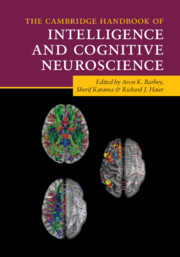Book contents
- The Cambridge Handbook of Intelligence and Cognitive Neuroscience
- Reviews
- The Cambridge Handbook of Intelligence and Cognitive Neuroscience
- Copyright page
- Dedication
- Contents
- Figures
- Tables
- Contributors
- Preface
- Part I Fundamental Issues
- Part II Theories, Models, and Hypotheses
- Part III Neuroimaging Methods and Findings
- 10 Diffusion-Weighted Imaging of Intelligence
- 11 Structural Brain Imaging of Intelligence
- 12 Functional Brain Imaging of Intelligence
- 13 An Integrated, Dynamic Functional Connectome Underlies Intelligence
- 14 Biochemical Correlates of Intelligence
- 15 Good Sense and Good Chemistry
- Part IV Predictive Modeling Approaches
- Part V Translating Research on the Neuroscience of Intelligence into Action
- Index
- References
13 - An Integrated, Dynamic Functional Connectome Underlies Intelligence
from Part III - Neuroimaging Methods and Findings
Published online by Cambridge University Press: 11 June 2021
- The Cambridge Handbook of Intelligence and Cognitive Neuroscience
- Reviews
- The Cambridge Handbook of Intelligence and Cognitive Neuroscience
- Copyright page
- Dedication
- Contents
- Figures
- Tables
- Contributors
- Preface
- Part I Fundamental Issues
- Part II Theories, Models, and Hypotheses
- Part III Neuroimaging Methods and Findings
- 10 Diffusion-Weighted Imaging of Intelligence
- 11 Structural Brain Imaging of Intelligence
- 12 Functional Brain Imaging of Intelligence
- 13 An Integrated, Dynamic Functional Connectome Underlies Intelligence
- 14 Biochemical Correlates of Intelligence
- 15 Good Sense and Good Chemistry
- Part IV Predictive Modeling Approaches
- Part V Translating Research on the Neuroscience of Intelligence into Action
- Index
- References
Summary
Intelligence is an elusive concept. For well over a century, what exactly intelligence is and how best to measure it has been debated (see Sternberg & Kaufman, 2011). In one predominant factorization of the components of intelligence it is separated into fluid and crystalized categories, with fluid intelligence measuring one’s reasoning and problem-solving ability, and crystallized intelligence measuring lifetime knowledge (Cattell, 1971). Influential theories of intelligence, particularly fluid intelligence, have proposed that aspects of cognitive control, most notably working memory, are the drivers of intelligent behavior (Conway, Getz, Macnamara, & Engel de Abreu, 2011; Conway, Kane, & Engle, 2003; Kane & Engle, 2002; Kovacs & Conway, 2016). More specifically, it is thought that the control aspect of working memory, the central executive proposed by Baddeley and Hitch (1974), is the basis for the types of cognitive processes tapped by intelligence assessments (Conway et al., 2003; Kane & Engle, 2002). It has further been proposed that the control process underlying intelligence may not be a single process, but instead a cluster of domain-general control processes, including attentional control, interference resolution, updating of relevant information, and others (Conway et al., 2011; Kovacs & Conway, 2016). Here, we focus on what we have learned about how intelligence emerges from brain function, taking the perspective that cognitive control ability and intelligence are supported by similar brain mechanisms, namely integration, efficiency, and plasticity. These mechanisms are best investigated using brain network methodology. From a network neuroscience perspective, integration refers to interactions across distinct brain networks; efficiency refers to the speed at which information can be transferred across the brain; and plasticity refers to the ability of brain networks to reconfigure, or rearrange, into an organization that is optimal for the current context. Therefore, we review relevant literature relating brain network function to both intelligence and cognitive control, as well as literature relating intelligence to cognitive control. Given the strong link between fluid intelligence, in particular, and cognitive control, we focus mainly on literature probing fluid intelligence in this chapter.
- Type
- Chapter
- Information
- Publisher: Cambridge University PressPrint publication year: 2021

